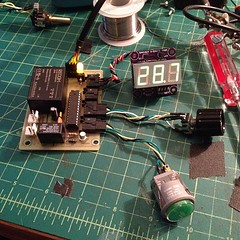New Workshop!
 We moved recently, and one of the features that drew us to our new home was a sun room in the back, maybe 8'x15', full of light and perfect for a workshop!
We moved recently, and one of the features that drew us to our new home was a sun room in the back, maybe 8'x15', full of light and perfect for a workshop!One corner is ideal for the laser, with a dryer vent for routing its (filtered) fumes outside. With two rolling racks for storage and two desks, I hope we'll have room for a small heavy bench and drill press. Good thing the Printrbot is (er, will be) small, we have big plans for this little room.
I got a kick out of reading my "Workshop!" post from two years ago, most of those projects haven't moved too much forward, but the grinder timer has gone through a few versions and the flight suit ended up being by far my most complicated project so far.







 I've been mesmerized by bouncing red LED's since the early '80s. LED's were mostly red, needle-style VU meters were on the outs, we hadn't yet graduated to green-yellow-red meters, and I grew a special place in my heart for those bouncing red lights. We also had
I've been mesmerized by bouncing red LED's since the early '80s. LED's were mostly red, needle-style VU meters were on the outs, we hadn't yet graduated to green-yellow-red meters, and I grew a special place in my heart for those bouncing red lights. We also had